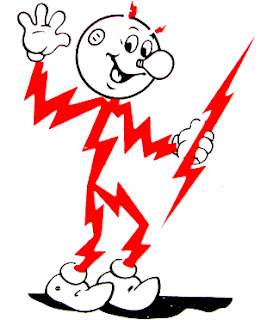When I am in my car I always have NPR (National Public Radio) on, it at least gives my grand-kids a good laugh, dispelling the myth that only music emits from a r-a-d-i-o s-t-a-t-i-o-n. Anyway today's offering really perked up my ears, to the point I actually stayed sitting in my car and listened to the end of the program - despite 100+ degree heat.
Today's program answered for me the question I had on Germany's sudden reversal on the nuclear power plant issue. Since Chancellor Angel Merkel announced that Germany would close all of their nuclear power plants by 2022 she rose to yes, almost angel heights in my eyes. But today on NPR I learned the reason for this reversal of position - it was the people!!!!
Do you hear that? The people made the difference -- "People Over Politics". Learning this has given me renewed hope, that if we can get the word out to the people, let them learn the facts, the true facts about nuclear power and the whole story, they too will join together and make their voices heard.
~ ~ ~
Germany’s Anti-Nuclear Shift

Anti-nuclear protest signs dot Germany's rural landscape. (Photo: Gerry Hadden)
Germany, Europe’s economic powerhouse, is undertaking a radical overhaul of its energy policy. The German government has pledged to ditch nuclear power by the year 2022. This significantly moves up an earlier end-date of 2040. The decision comes in the wake of the nuclear disaster in Fukushima, Japan. But that accident isn’t the only reason Germany’s government has approved the fast-track nuclear phase-out. Politics and popular protests have been the real catalysts for change.
Germany has been a hotbed of anti-nuclear activism for decades. You might remember those bumper stickers from the 70s—“Atomkraft—Nien Danke.” But the country has also long been committed to fighting climate change. And even some greens have embraced nuclear power as a lower-carbon alternative to fossil fuels.
So when push came to shove, Chancellor Angel Merkel decided last fall to keep Germany’s 17 nuclear plants running for 30 more years, to help meet the country’s CO2 emissions targets.
But then came the multiple meltdowns in Fukushima.
In late March, some 250,000 Germans took to the streets demanding the government close the country’s nuclear facilities immediately. Just days later, Germany’s anti-nuclear Green Party made historic gains in local elections. It was a huge blow to Merkel’s nuclear plans, and in April she finally relented.
“Step by step we will abandon nuclear energy by 2022,” she said. “This path is a big challenge for Germany, but it also means huge opportunities for future generations.”
It was a day Germany’s environmental movement had been fighting for, for decades: nuclear power will be phased out within ten years. And the country’s greens are relishing their victory. Katharina Fegebank, president of the Green Party in Hamburg, said the movement deserves most of the credit for the phase-out.
“Now our policy has become reality,” she said, “a political agenda shared by all other parties and that is fantastic. We should all be very proud of what we achieved over the last 30 years. It is our victory.”
Germany’s anti-nuclear movement has its roots in the 1960s. It began as a mix of anti-Cold War activists, environmentalists and locals opposed to nuclear waste storage sites in their communities.
And it has gained momentum from other nuclear accidents.
On a recent day, long time activist Kerstin Rudek stood outside a quiet train depot hidden among farms and forest in Lower Saxony, in northern Germany. Once a year, waste from Germany’s nuclear plants is brought here for transport to a nearby storage site.
“In 1979 there was a trek starting from here to Hannover,” she recounted. “When this trek started it was only a few farmers with a few tractors trying to get to Hannover. In this week Harrisburg happened.”
Harrisburg, being the nuclear accident at Three Mile Island, near Harrisburg, Pennsylvania.
“So instead there were about 100,000 people reaching Hannover. It was a very big manifestation.”
The waste storage facility, in the village of Gorleben, was eventually built despite popular opposition. But the anti-nuke demonstrations have continued with remarkable strength over the decades since, until Fukushima pushed popular sentiment to a point that the government couldn’t ignore.
But Rudek said that despite the decision to phase out nuclear power, protesters need to keep the pressure on to make sure future German governments don’t back peddle on the 2022 deadline.
“We see the problem that people might not fight for their rights themselves,” she said, “and just leave it to the parliament, and this will not work out. We have to be stronger than before.”
But phasing out nuclear power and dealing with the waste is just one half of Germany’s post-nuclear energy challenge. The other half is finding ways to replace the huge amount of lost power with renewable energy sources.
Chancellor Merkel says she is committed to that. But Kristoph von Lieven, of Greenpeace in Hamburg, said the government must put its full backing behind the plan for it to work.
“They’ve supported the nuclear power plants on in Germany in last 20 years with over 200 billion euros,” he said. “This money, invested in renewables, would be more than sufficient.”
Money is just one of many obstacles as Germany gears up to switch from nuclear to renewable energy. And even environmentalists can’t all agree on the way forward.
Photo Information:
Kudek said 32 years ago a tiny, local protest here against the proposed site suddenly went viral. Activist Kersten Kudek stands beneath a giant yellow X erected in woodlands near a nuclear waste storage facility. The X has become the dominant symbol of popular rejection of the storage sites. (Photo: Gerry Hadden)
Your can hear today's NPR The World Audio Here: Play | Download






















